

When you are into serious photography business, you must make sure that you license your captured photographs when it is used by another person or company. This can be done by providing them a photography license agreement stipulating the terms on how, when, and when the licensee, the person who is gaining the rights to use the image, can use your photograph. Note that in this agreement templates, the copyright is not being sold; you retain the copyright of the image and you only license your photograph to be used by another party. In order to help you create an appropriate photography license agreement in a proper format, provided below are some examples that you can refer to
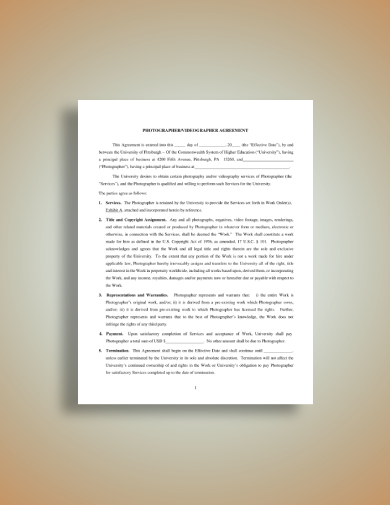
Before providing photography and videography services to your customer, it is important that both parties must sign first this photography and videography license agreement for the protection of both parties. This service agreement explains, lists, and enumerates the services needed to be rendered by the photographer, representations and warranties, payment, termination, independent contractor, liability, insurance, background check, choice of law, and assignment. The names and signatures of both parties must be affixed at the end part of the agreement.
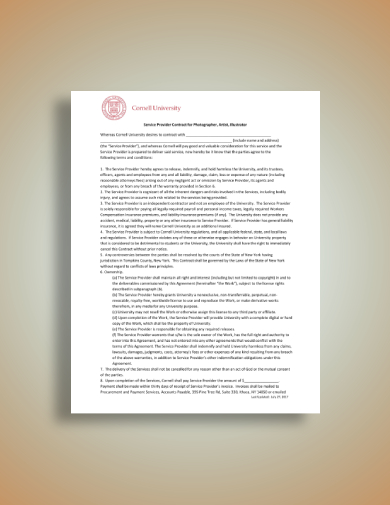
Photographer, artist, and illustration have related and interconnected job as regards taking photographs and editing them on the computer. All of them also require to have an agreement with the clients regarding the terms and conditions in providing professional services. In this example, the service provider made contract with a university regarding the type of service they must provide, the payment for such services, the assumption of the dangers and risks while performing the services, the stipulation regarding disputes, and a lot more.
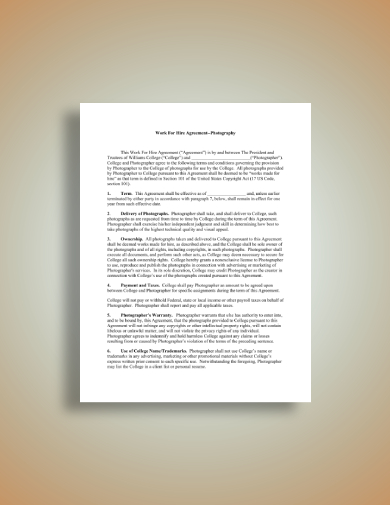
In this concise photography license agreement, stipulated are the terms of the agreement, the delivery of the services, ownership, payment and taxes, photographer’s warranty, the use of trademarks, termination, and miscellaneous. The agreement is created in a concise and direct manner, making the stipulations in the agreement easy to understand and avoiding possible misunderstanding and conflicts in the future. At the end of the document, a space is provided where the photographer and client must affix their signatures. The date of the agreement must also be stated after the signatures.
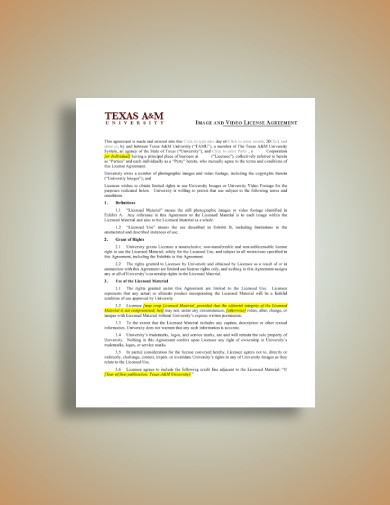
It is typical for schools and universities to avail the photography services of an independent, professional photographer in capturing photos during an event, photos of the school building and premises, and photos for documentation purposes. In order for the university and the photographer to come up with the terms and conditions regarding the services to be rendered, a university photography license agreement is needed, just like the one presented above. It typically contains the general terms and conditions as regards the services to be provided as well as the payment terms and trademark provisions.
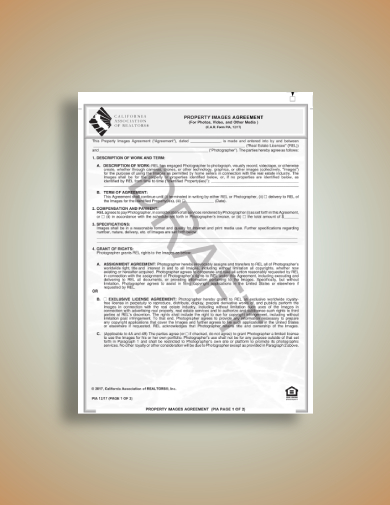
Real estate photography is often used when one creates a photography flyer, poster, banner, and other marketing material in order to provide the potential customer a good-quality photograph of the property that they might want to purchase, rent, or lease. Alternatively, this can also be used by a real estate company as a picture on their website or social media. Hence, because of this dire need of real estate photography, photographers must protect the copyright of their works by providing a real estate photograph license agreement similar to this example. Note that when the photographer is working for a certain real estate company, there is no need to license the photographs as they are taken solely for that particular company.
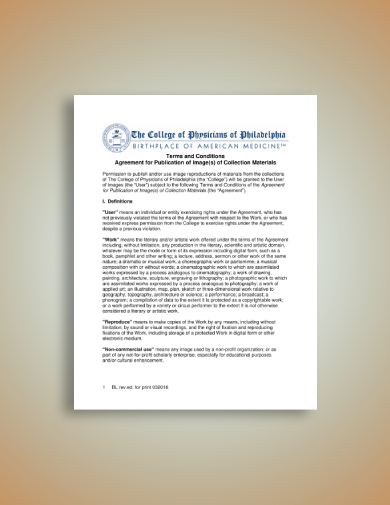
Colleges and departments are also among the those that need photography services for a lot of purposes other than capturing events and school activities. In this regard, there must be a college photography license agreement that must be signed by the contracting parties. It must clearly specify the terms and conditions of the agreement, including the general provisions as regards permission to publish, copies of permitted work, credit, non-exclusive license, fees, limitations of liability, alteration and correction, user’s indemnification, image specifications, reprint rights, reservation of rights, electronic reproduction, credit line, and many others—kind of similar to a patent license agreement.
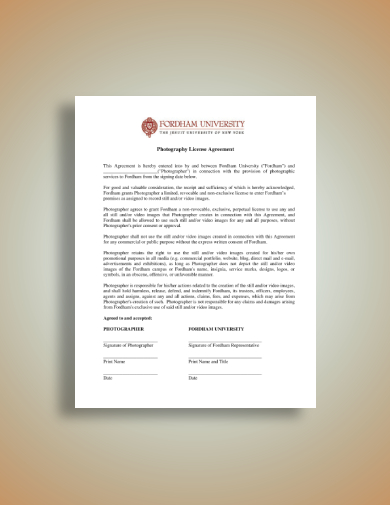
Agreements need not be overwhelming so that it can easily be understood by both parties. Just like in this short photography, provided are brief and concise terms and conditions of the contract agreement. It briefly discusses the consideration for the services to be provided by the photographer, the exclusive right granted by the licensor to the licensee, the use of the photographs, the right to print and reprint, and the signatures of the client and photographer confirming the stipulations on the agreement.
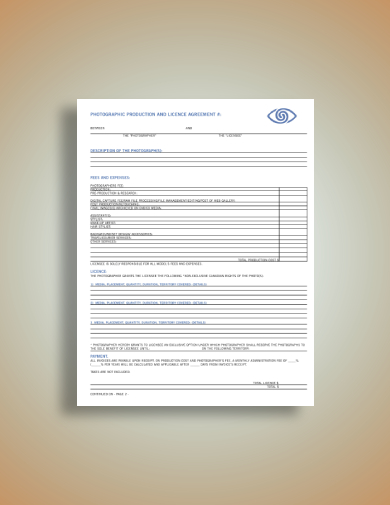
In this license agreement, it provides the details of the agreement, such as the parties making the contract, description of the photographs, fees and expenses, non-exclusive license rights, payments, owner of the copyright, copies and reprint, and signatures of the parties. The agreement is designed in a way that it clearly presents all the items that need to be agreed by both parties concerning the services to be provided by the photographer.
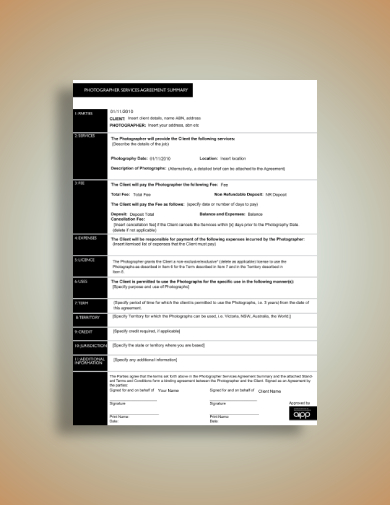
When creating an agreement, it is best that you design it in a way that it is simple and comprehensible, just like this photography license and service agreement. The items in the agreement are carefully organized so it would be easily understandable by the reader. It has the following contained in the agreement: parties, services, free, expenses, license, uses, term, territory, credit, jurisdiction, and additional information. The standard terms and conditions are also summarized in the next page of the agreement.

Photography and design services must follow a standard form of agreement, similar to agreement contained in this example. It must provide the basic terms and conditions, license for limited usage, assignment of rights, work made for hire, print-specific conditions, environmental-specific conditions, and motion-specific conditions. All these items must be presented in detail but in a brief and direct manner. Just like all other agreements, the parties to the agreement must sign the legal document.